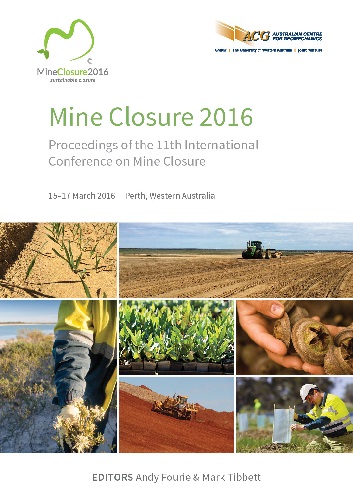Mine site rehabilitation — are we reinventing the wrong wheel?

|
Authors: Williams, DJ |
DOI https://doi.org/10.36487/ACG_rep/1608_44_Williams
Cite As:
Williams, DJ 2016, 'Mine site rehabilitation — are we reinventing the wrong wheel?', in AB Fourie & M Tibbett (eds), Mine Closure 2016: Proceedings of the 11th International Conference on Mine Closure, Australian Centre for Geomechanics, Perth, pp. 595-608, https://doi.org/10.36487/ACG_rep/1608_44_Williams
Abstract:
Mine site rehabilitation generally aims to produce a safe, stable and non-polluting post-mining landscape that serves some agreed post-mining land use. Historically, the presumed post-mining land use has generally driven the rehabilitation process, often regardless of whether the adopted land use matches the pre-mining land use or is achievable. This dictates the flattening of the mine waste landform and the choice of surface cover applied. In the past, the adopted post-mining land use has often been grazing, which dictates that steep (usually angle of repose) mine waste slopes be flattened substantially, and that the surface be topsoiled and grassed. The tops of surface dumps and tailings surfaces often require reshaping to enhance surface drainage or water management prior to capping, topsoiling and grassing. The outer slopes of waste dumps and tailings storage facilities are generally flattened to allow access for equipment, topsoiling and grassing, possibly with the aim of allowing grazing. Even where grazing is not to be the post mining land use, slope flattening, topsoiling, and grassing are often adopted. Whether or not grazing is the adopted post-mining land use, it may not be utilised, and a grass cover may be difficult to establish and even more difficult to sustain. Further, the limited extent to which steep mine waste slopes can be flattened generally results in slope angles that are still too steep for grazing use, and are prone to erosion, particularly if covered with topsoil and the grass cover is inadequate. This historical approach to mine site rehabilitation has led to repeated failures of flattened, topsoiled and grassed steep mine waste slopes and of regraded, capped, topsoiled and grassed dump tops and tailings. Increasingly, the establishment and sustainability of ecological functionality is seen as the key to achieving a safe, stable, and non-polluting post-mining landscape. Hence, it is argued that ecological function should be the preferred driver of mine site rehabilitation over the post-mining land use, since it better addresses the accepted rehabilitation aims. The paper presents a history of the conventional approach to mine site rehabilitation governed by slope flattening, topsoiling and grass covers, illustrated with global examples of mine site rehabilitation failures due to the adoption of those practices. These include examples from gold mining in Johannesburg, surface coal mining in Australia, and metalliferous mining in Australia, and focusses on the rehabilitation of steep mine slopes in tailings, spoil or waste rock.
Keywords: ecological function, erosion, grazing, land use, regrading, rehabilitation, slope stability
References:
CQCA Act 1968, Central Queensland Coal Associates Agreement Act 1968 – Schedule 1, viewed 24 August 2015,
CQCA Act 1997, Central Queensland Coal Associations Agreement Amendment Bill 1997, viewed 24 August 2015,
Hannan, JC 1978, ‘Rehabilitation of mined areas’, Australian Mining, 70(2), pp. 34–45.
Hannan, JC 1984, Mine rehabilitation: A handbook for the coal mining industry, NSW Coal Association.
Hannan, JC & Bell, LC 1993, ‘Surface Rehabilitation’, in AJ Hargraves & CH Martin (eds), Australasian Coal Mining Practice, Monograph Series no. 12, The AusIMM, Melbourne, Australia, pp. 260–280.
Leps, TM 1970, ‘Review of shearing strength of rockfill’, in Proceedings of ASCE, Journal of Soil Mechanics and Foundation Engineering Division, 96(SM4), pp. 1159–1170.
Mason, JE 2012, ‘Picturing the beloved country: Margaret Bourke-White’, Life Magazine, and South Africa, 1949-1950, Kronos, 38(1).
Mitsubishi Corporation 2015, BHP Billiton Mitsubishi Alliance Mines, NSW Department of Primary Industry, 2007, viewed 24 August 2015,
NSW DPI (New South Wales Department of Primary Industries) 2007, ‘Hunter Key Site’, Key Sites — Land Use to Manage Water & Salt, viewed 24 August 2015,
Reichardt, MT & Witkowski, ETF 2014, ‘South Africa’s mine waste rehabilitation 1910–1991: personalities, economics, organisations and legislation that shaped the development of an applied science’, in Proceedings of Mine Closure 2014, p. 18.
Williams, DJ 2001a, ‘Prediction of erosion from steep mine slopes’, International Journal of Environmental Management and Health, 12(1), pp. 35–50.
Williams, DJ 2001b, Risk Assessment of Bowen Basin Spoil Rehabilitation – Final Report, ACARP Project No 8039, 1999-2001, p. 135.
Williams, DJ 2001c, Risk Assessment of Bowen Basin Spoil Rehabilitation – Literature Review and Commentary, ACARP Project No 8039, 1999-2001, p. 109.
Williams, DJ 2006, ‘The case for revolutionary change to mine waste disposal and rehabilitation’, in Proceedings of Second International Seminar on Strategic versus Tactical Approaches to Mining, Australian Centre for Geomechanics, Perth, p. 19.
Williams, DJ 2014, ‘Keynote Lecture: Mine planning for the final landform’, in Proceedings of Fifth International Mining and Industrial Waste Management Conference, p. 52.
© Copyright 2025, Australian Centre for Geomechanics (ACG), The University of Western Australia. All rights reserved.
View copyright/legal information
Please direct any queries or error reports to repository-acg@uwa.edu.au
View copyright/legal information
Please direct any queries or error reports to repository-acg@uwa.edu.au